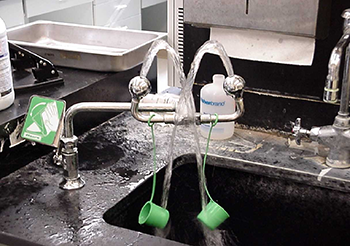Are you Flushing your Eyewash Weekly?

The American Industrial Hygiene Association Journal published an interesting article in their July 1996 edition titled “Quantitation of free-living amoebae and bacterial populations in eyewash stations relative to flushing frequency”, by Bowman EK, Vass AA, Mackowski R, Owen BA, Tyndall RL.
The study investigated the concentration of amoebic and bacterial populations in eyewash station water relative to various flushing regimens.
Amoeba concentrations averaged approximately 200 amoeba/100 ml in 13 of 15 stations positive for amoeba and consisted of Hartmannella and Acanthamoeba. Bacterial concentrations ranged from 10(0) to more than 10(5) colony forming units per ml. Further study indicated that removal of diffusing screens did not substantially change (p > 0.05) the concentration of amoeba. Amoebic and bacterial concentrations temporarily decreased with the various flushing regimens tested. Weekly 3-minute flushes appeared to be more effective in maintaining lowered bacterial concentrations (p < 0.0001).
This study demonstrates the importance of flushing your eye wash stations on a weekly basis. Eyewash stations must be flushed weekly for 3 minutes. This will not only reduce microbial growth in the eyewash, but it will also alert you to any mechanical problems or excessive hard water build up. The American National Standard for Emergency Eyewash and Shower Equipment, (ANSI Z358.1-2014) requires activation of plumbed eye/face wash units at least weekly. (Section 6.5.2) and inspection of all eye/face wash units annually for compliance with standard. (Section 6.5.5).
Please click on the following links for a weekly log that can be printed off and used to keep a record of the weekly flushing of your emergency eyewash stations. One is a simple date log or you can choose a more detailed checklist that includes additional inspection details.
Our inspectors test all eyewash stations during the annual Laboratory Safety Survey. If an eyewash station does not pass inspection, the surveyor will be asking for this maintenance log and if you do not have one available then you will be cited for not maintaining your emergency equipment. Additionally, outside regulatory agencies such as CAP, AAALAC and the VA require maintaining a weekly eyewash flushing chart. Remember that maintaining your eyewash is your responsibility, so don’t let your eyes down. Please contact our office at ehs@iupui.edu or 274-2005 if you have any questions. |